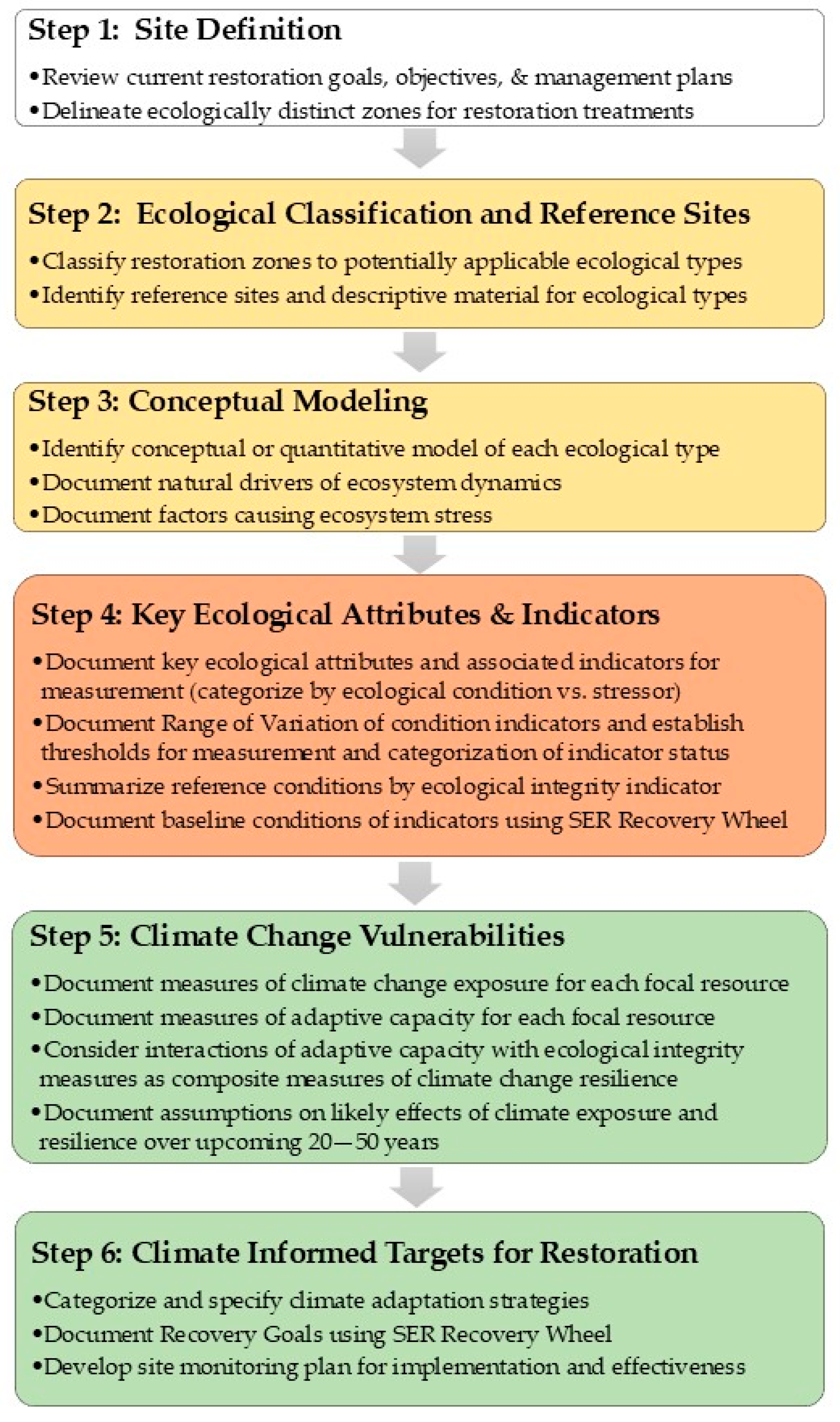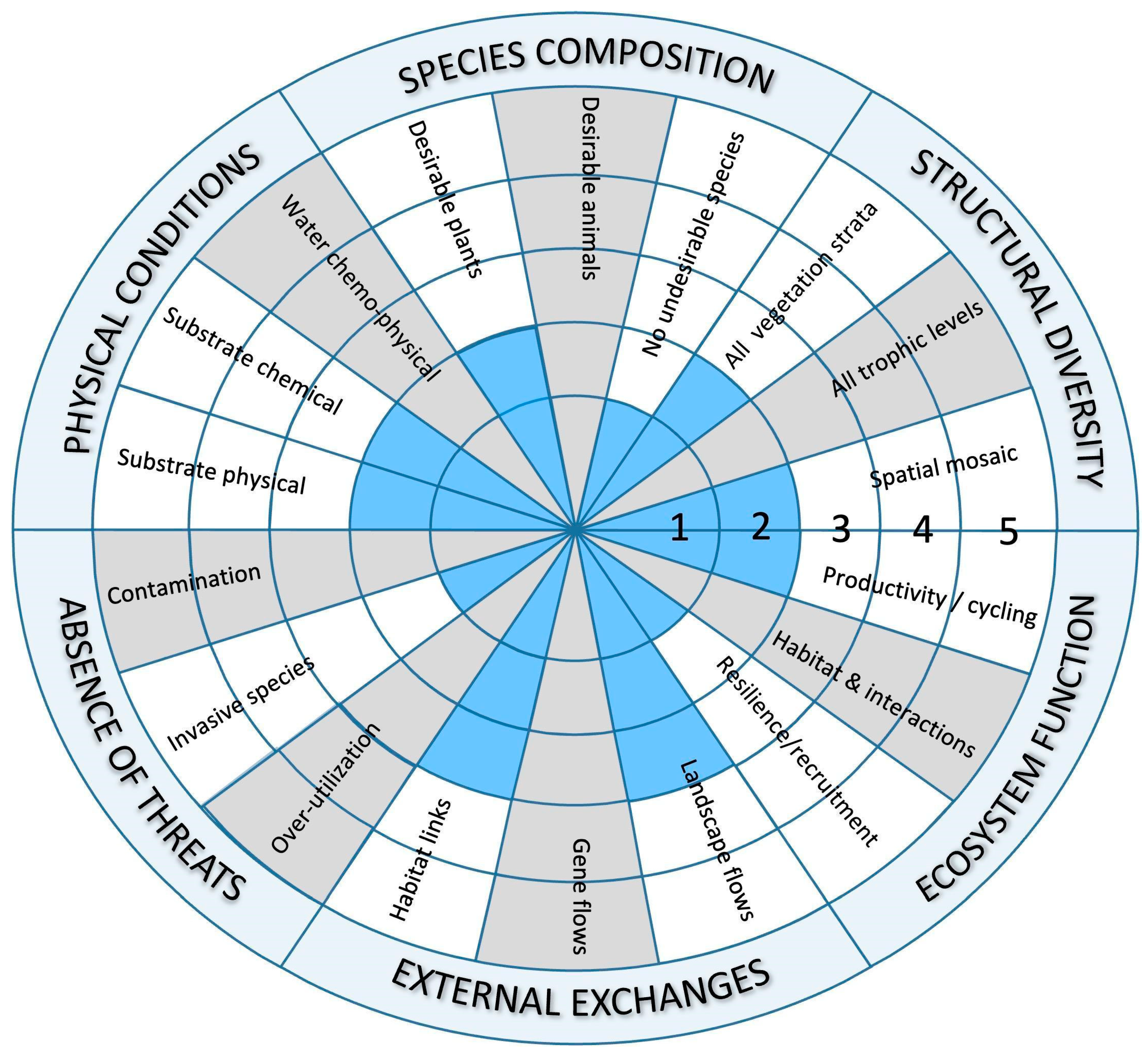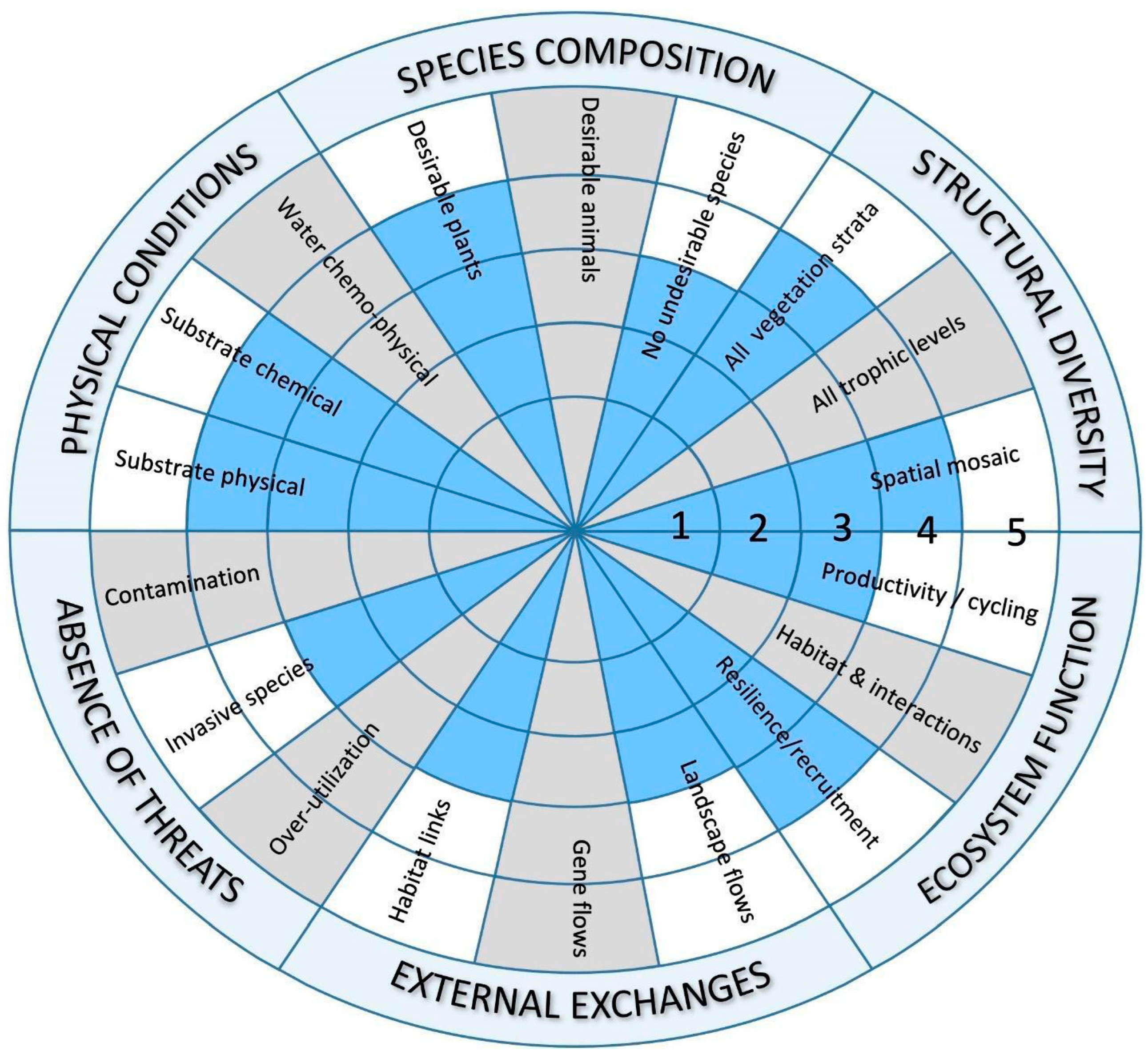Establishing Reference Models for Ecological Restoration—Case Study from Colorado National Monument, USA
Abstract
1. Introduction
- The potential for alternative condition states and recovery trajectories with compositional and structural characteristics [5].
- The likelihood that reference conditions will change during the process of recovery in the degraded system [6].
- Reference sites or the modeled condition should be placed in the context of the broader landscape conditions [7].
2. Materials and Methods
2.1. Colorado National Monument—Case Study
2.2. Workflow, Analytical Frameworks, and Data Sources
2.3. Ecosystem Classifications (Step 2)
2.4. Reference Data Describing the Types to Be Restored (Step 2)
2.5. Modeling Landscape and Ecosystem Dynamics (Step 3)
2.6. Identify Indicators for Restoring Ecological Integrity (Step 4)
- (1)
- Key Ecological Attributes (KEAs) driving natural states and transitions;
- (2)
- Measurable indicators of those attributes;
- (3)
- The expected/historic range of variation for each condition indicator;
- (4)
- Practical thresholds for indicator measurements suggesting categories for the current status and potential restoration milestones.
2.7. SER Five-Star System and Ecological Recovery Wheel (Step 4, 6)
2.8. Vulnerability and Adaptation to Climate Change (Step 5)
3. Results
3.1. Classification and Reference Sites (Step 2)
3.2. Reference Site Data Describing the Types to Be Restored (Step 2)
3.3. State-and-Transition Models (Step 3)
- (A)
- Early Development 1 All Structures (15% of this type in this stage)
- (B)
- Mid Development 1 Open (shrub-dominated—50% of this type in this stage)
- (C)
- Mid Development 1 Closed (shrub-dominated—25% of this type in this stage)
- (D)
- Late Development 1 Open (5% of this type in this stage)
- (E)
- Late Development 1 Closed (5% of this type in this stage)
3.4. Key Ecological Attributes and Indicators of Ecological Integrity (Step 4)
- Landscape-scale processes requiring connectivity.
- Community composition contribution to characteristic ecological processes.
- Vegetation structural responses to disturbances.
- Wildfire regimes.
- Chemical and physical processes.
3.4.1. Expected/Historical Ranges of Variation for Indicators
3.4.2. Indicator Thresholds
3.4.3. Scorecard of Indicators and Ratings
3.5. Accounting for Climate Change (Step 5)
3.6. Preliminary Reference Goals by Ecosystem Attribute and Sub-Attribute (Step 6)
4. Discussion
4.1. Challenges in Ecological Restoration
4.2. Coping with Uncertainty
4.3. Coping with Climate-Induced Stress When Developing Restoration Goals
5. Conclusions
Supplementary Materials
Author Contributions
Funding
Data Availability Statement
Acknowledgments
Conflicts of Interest
References
- FAO; SCBD; SER. Delivering Restoration Outcomes for Biodiversity and Human Well-Being—Resource Guide to Target 2 of the Kunming-Montreal Global Biodiversity Framework; Food and Agriculture Organization of the United Nations: Rome, Italy; Montreal, QC, Canada; Washington, DC, USA, 2024. [Google Scholar] [CrossRef]
- FAO; IUCN/CEM; SER. Principles for Ecosystem Restoration to Guide the United Nations Decade 2021–2030; Food and Agriculture Organization of the United Nations: Rome, Italy, 2024; Available online: https://openknowledge.fao.org/handle/20.500.14283/cb6591en (accessed on 15 April 2025).
- Gann, G.D.; McDonald, T.; Walder, B.; Aronson, J.; Nelson, C.R.; Jonson, J.; Hallett, J.G.; Eisenberg, C.; Guariguata, M.R.; Liu, J.; et al. International principles and standards for the practice of ecological restoration. Second edition: Society for Ecological Restoration, Washington, D.C. 20005 U.S.A. Restor. Ecol. 2019, 27, S1–S46. Available online: https://www.ser.org/page/standards-tools (accessed on 15 January 2023). [CrossRef]
- Atkinson, J.; Brudvig, L.A.; Mallen-Cooper, M.; Nakagawa, S.; Moles, A.T.; Bonser, S.P. Terrestrial ecosystem restoration increases biodiversity and reduces its variability, but not to reference levels: A global meta-analysis. Ecol. Lett. 2022, 25, 1725–1737. [Google Scholar] [CrossRef]
- Suding, K.N.; Gross, K.L.; Houseman, G.R. Alternative States and Positive Feedbacks in Restoration Ecology. Trends Ecol. Evol. 2004, 19, 46–53. [Google Scholar] [CrossRef]
- Kirkman, L.K.; Barnett, A.; Williams, B.W.; Hiers, J.K.; Pokswinski, S.M.; Mitchell, R.J. A Dynamic Reference Model: A Framework for Assessing Biodiversity Restoration Goals in a Fire-Dependent Ecosystem. Ecol. Appl. 2013, 23, 1574–1587. [Google Scholar] [CrossRef]
- Stoddard, J.; Larsen, D.; Hawkins, C.; Johnson, R.; Norris, R. Setting Expectations for the Ecological Condition of Streams: The Concept of Reference Condition. Ecol. Appl. 2006, 16, 1267–1276. [Google Scholar] [CrossRef]
- Unnasch, R.S.; Braun, D.P.; Comer, P.J.; Eckert, G.E. The Ecological Integrity Assessment Framework: A Framework for Assessing the Ecological Integrity of Biological and Ecological Resources of the National Park System (Version 1.1); Natural Resource Report. NPS/NRSS/BRD/NRR—2018/1602; National Park Service: Fort Collins, CO, USA, 2018.
- Hiers, J.K.; Jackson, S.T.; Hobbs, R.J.; Bernhardt, E.S.; Valentine, L.E. The Precision Problem in Conservation and Restoration. Trends Ecol. Evol. 2016, 31, 820–830. [Google Scholar] [CrossRef]
- Oliver, I.; Dorrough, J.; Travers, S.K. The acceptable range of variation within the desirable stable state as a measure of restoration success. Restor. Ecol. 2023, 31, e13800. [Google Scholar] [CrossRef]
- Constantz, B.M.; Stella, J.C.; Holl, K.D. Diverging Restoration Pathways for Overstory and Understory Communities in a Mediterranean-Climate Riparian Ecosystem. Ecol. Appl. 2025, 35, e70043. [Google Scholar] [CrossRef] [PubMed]
- Sluis, W.; Kucera, K.; Sullivan, G. Establishing the plant component of a tallgrass prairie restoration using a remnant reference ecosystem model: A case study. Ecol. Solut. Evid. 2025, 6, e70014. [Google Scholar] [CrossRef]
- Benck, K.M.; Allen, K.; Nadeau, A.; Davis, A.; Gardner, S.; Randerson, M.; Robertson, A. Colorado National Monument: Natural Resources Condition Assessment; Natural Resource Report. NPS/COLM/NRR—2016/1356; National Park Service: Fort Collins, CO, USA, 2016.
- Murphy, M. Colorado National Monument West Entrance Site History and Ongoing Early Season Invasive Control Project: Restoration and monitoring efforts to repair damage from human activity Molly Murphy, 2014–2020 Gilbert Moreno, 2014–2015 Amy Birtwistle. 2015; US National Park Service Unpublished work. [Google Scholar]
- Palmquist, K.A.; Schlaepfer, D.R.; Renne, R.R.; Torbit, S.C.; Doherty, K.E.; Remington, T.E.; Watson, G.; Bradford, J.B.; Lauenroth, W.K. Divergent climate change effects on widespread dryland plant communities driven by climatic and ecohydrological gradients. Glob. Change Biol. 2021, 27, 5169–5185. [Google Scholar] [CrossRef]
- Palmquist, K.A.; Schlaepfer, D.R.; Bradford, J.B.; Lauenroth, W.K. Mid-latitude shrub steppe plant communities: Climate change consequences for soil water resources. Ecology 2016, 97, 2342–2354. [Google Scholar] [CrossRef]
- Chambers, J.C.; Brown, J.L.; Bradford, J.B.; Doherty, K.E.; Crist, M.R.; Schlaepfer, D.R.; Urza, A.K.; Short, K.C. Combining resilience and resistance with threat-based approaches for prioritizing management actions in sagebrush ecosystems. Conserv. Sci. Pract. 2023, 5, e13021. [Google Scholar] [CrossRef]
- National Park Service (NPS). Management Policies; U.S. Department of the Interior, National Park Service: Washington, DC, USA, 2006.
- Ivanova, N. Global overview of the application of the Braun-Blanquet approach in research. Forests 2024, 15, 937. [Google Scholar] [CrossRef]
- Mücher, C.A.; Klijn, J.A.; Wascher, D.M.; Schaminée, J.H. A new European Landscape Classification (LANMAP): A transparent, flexible and user-oriented methodology to distinguish landscapes. Ecol. Indic. 2010, 10, 87–103. [Google Scholar] [CrossRef]
- Keith, D.A.; Ferrer-Paris, J.R.; Nicholson, E.; Bishop, M.J.; Polidoro, B.A.; Ramirez-Llodra, E.; Tozer, M.G.; Nel, J.L.; Mac Nally, R.; Gregr, E.J.; et al. A function-based typology for Earth’s ecosystems. Nature 2022, 610, 513–518. [Google Scholar] [CrossRef] [PubMed]
- Faber-Langendoen, D.; Keeler-Wolf, T.; Meidinger, D.; Tart, D.; Hoagland, B.; Josse, C.; Navarro, G.; Ponomarenko, S.; Saucier, J.P.; Weakley, A.; et al. EcoVeg: A new approach to vegetation description and classification. Ecol. Monogr. 2014, 84, 533–561. [Google Scholar] [CrossRef]
- Caudle, D.; DiBenedetto, J.; Karl, M.; Sanchez, H.; Talbot, C. Interagency Ecological Site Handbook for Rangelands; U.S. Department of the Interior, Bureau of Land Management: Washington, DC, USA, 2013.
- Comer, P.; Faber-Langendoen, D.; Evans, R.; Gawler, S.; Josse, C.; Kittel, G.; Menard, S.; Pyne, M.; Reid, M.; Schulz, K.; et al. Ecological Systems of the United States: A Working Classification of US Terrestrial Systems; NatureServe: Arlington, VA, USA, 2003. [Google Scholar]
- Higgins, J.V.; Bryer, M.T.; Khoury, M.L.; Fitzhugh, T.W. A freshwater classification approach for biodiversity conservation planning. Conserv. Biol. 2005, 19, 432–445. [Google Scholar] [CrossRef]
- Toma, T.S.P.; Overbeck, G.E.; de Souza Mendonça, M., Jr.; Fernandes, G.W. Optimal references for ecological restoration: The need to protect references in the tropics. Perspect. Ecol. Conserv. 2023, 21, 25–32. [Google Scholar] [CrossRef]
- Higgins, K.F.; Uresck, D.W.; Perkins, L.B.; Jensen, K.C. Vegetation Sampling. The Wildlife Techniques Manual: Volume 1: Research. Volume 2. Management 2020, 28, 409. [Google Scholar]
- Dengler, J.; Jansen, F.; Glöckler, F.; Peet, R.K.; De Cáceres, M.; Chytrý, M.; Ewald, J.; Oldeland, J.; Lopez-Gonzalez, G.; Finckh, M.; et al. The Global Index of Vegetation-Plot Databases (GIVD): A new resource for vegetation science. J. Veg. Sci. 2011, 22, 582–597. [Google Scholar] [CrossRef]
- Von Loh, J.; Landgraf, K.; Evenden, A.; Owens, T.; Blauer, S.; Reid, M. Vegetation Classification and Mapping Project Report, Colorado National Monument; Natural Resource Technical Report. NPS/NCPN/NRTR—2007/061; Natural Resource Program Center: Fort Collins, CO, USA, 2007.
- Daniel, C.J.; Frid, L.; Sleeter, B.M.; Fortin, M.J. State-and-transition simulation models: A framework for forecasting landscape change. Methods Ecol. Evol. 2016, 7, 1413–1423. [Google Scholar] [CrossRef]
- Briske, D.D.; Bestelmeyer, B.T.; Stringham, T.K.; Shaver, P.L. Recommendations for development of resilience-based state-and-transition models. Rangel. Ecol. Manag. 2008, 61, 359–367. [Google Scholar] [CrossRef]
- Rollins, M.G. LANDFIRE: A nationally consistent vegetation, wildland fire, and fuel assessment. Int. J. Wildland Fire 2009, 18, 235–249. [Google Scholar] [CrossRef]
- Parrish, J.D.; Braun, D.P.; Unnasch, R.S. Are we conserving what we say we are? Measuring ecological integrity within protected areas. BioScience 2003, 53, 851–860. [Google Scholar] [CrossRef]
- Standards Reference Group (SERA). National Standards for the Practice of Ecological Restoration in Australia, Edition 2.1. Society for Ecological Restoration Australasia. In Consultation with Key Partners; 2018; 46p., Available online: https://www.seraustralasia.com/standards/home.html (accessed on 15 July 2025).
- Suding, K.N.; Collins, C.G.; Hallett, L.M.; Larios, L.; Brigham, L.M.; Dudney, J.; Farrer, E.C.; Larson, J.E.; Shackelford, N.; Spasojevic, M.J. Biodiversity in changing environments: An external-driver internal-topology framework to guide intervention. Ecology 2024, 105, e4322. [Google Scholar] [CrossRef]
- Young, R.E.; Gann, G.D.; Walder, B.; Liu, J.; Cui, W.; Newton, V.; Nelson, C.R.; Tashe, N.; Jasper, D.; Silveira, F.A.; et al. International principles and standards for the ecological restoration and recovery of mine sites. Restor. Ecol. 2022, 30, e13771. [Google Scholar] [CrossRef]
- Qin, D.; Chen, Z.; Averyt, K.B.; Miller, H.L.; Solomon, S.; Manning, M.; Marquis, M.; Tignor, M. IPCC: Summary for Policymakers; Cambridge University Press: Cambridge, UK; New York, NY, USA, 2007. [Google Scholar]
- Jurgilevich, A.; Räsänen, A.; Groundstroem, F.; Juhola, S. A systematic review of dynamics in climate risk and vulnerability assessments. Environ. Res. Lett. 2017, 12, 013002. [Google Scholar] [CrossRef]
- Comer, P.J.; Hak, J.C.; Reid, M.S.; Auer, S.L.; Schulz, K.A.; Hamilton, H.H.; Smyth, R.L.; Kling, M.M. Habitat climate change vulnerability index applied to major vegetation types of the western interior United States. Land 2019, 8, 108. [Google Scholar] [CrossRef]
- Schmitz, O.J.; Lawler, J.J.; Beier, P.; Groves, C.; Knight, G.; Boyce, D.A.; Bulluck, J.; Johnston, K.M.; Klein, M.L.; Muller, K.; et al. Conserving biodiversity: Practical guidance about climate change adaptation approaches in support of land-use planning. Nat. Areas J. 2015, 35, 190–203. [Google Scholar] [CrossRef]
- Comer, P.J.; Seddon, E. Climate Change Adaptation Zones in Pinyon-Juniper Woodlands of Western North America. Forests 2023, 14, 1533. [Google Scholar] [CrossRef]
- Hak, J.C.; Comer, P.J. Modeling landscape condition for biodiversity assessment—Application in temperate North America. Ecol. Indic. 2017, 82, 206–216. [Google Scholar] [CrossRef]
- Keith, D.A.; Rodríguez, J.P.; Rodríguez-Clark, K.M.; Nicholson, E.; Aapala, K.; Alonso, A.; Asmussen, M.; Bachman, S.; Basset, A.; Barrow, E.G.; et al. Scientific foundations for an IUCN Red List of Ecosystems. PLoS ONE 2013, 8, e62111. [Google Scholar] [CrossRef]
- Schuurman, G.W.; Cole, D.N.; Cravens, A.E.; Covington, S.; Crausbay, S.D.; Hawkins Hoffman, C.; Lawrence, D.J.; Magness, D.R.; Morton, J.M.; Nelson, E.A.; et al. Navigating Ecological Transformation: Resist-Accept-Direct as a Path to a New Resource Management Paradigm. BioScience 2022, 72, 16–29. [Google Scholar] [CrossRef]
- Peterson St-Laurent, G.; Oakes, L.E.; Cross, M.; Hagerman, S. R–R–T (resistance—resilience—transformation) typology reveals differential conservation approaches across ecosystems and time. Commun. Biol. 2021, 4, 39. [Google Scholar] [CrossRef] [PubMed]
- Fernández-Giménez, M.E.; Augustine, D.J.; Porensky, L.M.; Wilmer, H.; Derner, J.D.; Briske, D.D.; Stewart, M.O. Complexity fosters learning in collaborative adaptive management. Ecol. Soc. 2019, 24, 29. Available online: https://www.ecologyandsociety.org/vol24/iss2/art29/ (accessed on 15 July 2025). [CrossRef]
- Tedesco, A.M.; López-Cubillos, S.; Chazdon, R.; Rhodes, J.R.; Archibald, C.L.; Pérez-Hämmerle, K.V.; Brancalion, P.H.; Wilson, K.A.; Oliveira, M.; Correa, D.F.; et al. Beyond ecology: Ecosystem restoration as a process for social-ecological transformation. Trends Ecol. Evol. 2023, 38, 643–653. [Google Scholar] [CrossRef]




| Ecosystem Attribute | Sub-Attribute(s) | Indicator (Stressors in Italics) |
|---|---|---|
| Absence of threats | Invasive Species |
|
| Physical Conditions | Substrate physical/chemical |
|
| Species Composition | Desirable plants No undesirable species |
|
| Structural Diversity | All vegetation strata Spatial mosaic |
|
| Ecosystem Function | Resilience/Recruitment |
|
| External Exchanges | Landscape and Gene Flows, Habitat Links |
|
| Attribute Category | Star Level (1–5) | SER Ranking Guidance | Evidence for Recovery Level |
|---|---|---|---|
| Absence of Threats | |||
| Invasive species | 1 | Some invasive species drivers (e.g., planting or releasing invasive species, contaminated equipment or supplies) are absent, but others remain high in number and degree (e.g., >25% relative cover of reproductive invasive plants at the site). |
|
| Physical Conditions | |||
| Substrate physical/chemical | 2 | Physical properties of substrates (e.g., soil structure and layers, topography, erosion, compaction, and temperature) remain at low similarity levels relative to the reference, but they are capable of supporting some characteristic native biota. |
|
| Species Composition | |||
| Desirable Plants | 2 | A small subset of characteristic native plant, fungi, and lichen species present (e.g., >25% richness and evenness of the reference) across the site. Very high levels of nonnative, invasive or other undesirable plants (e.g., >50% relative species richness, abundance, or cover) or non-native or undesirable animals. |
|
| No undesirable species | 1 |
| |
| Structural Diversity | |||
| All vegetation strata | 2 | Multiple strata of the reference are present and remain at low similarity levels relative to the reference, but they are capable of supporting some biota of the reference. Some similarity of spatial distribution of features (e.g., vegetation, animal populations, habitats) is seen relative to reference throughout most of the site. |
|
| Spatial Mosaic | 2 | ||
| Ecosystem Function | |||
| Productivity/Cycling | 2 | Low numbers and levels of physical and biological processes and functions (e.g., photosynthesis and growth, water and nutrient cycling), relative to the reference are present. |
|
| Resilience/Recruitment | 1 | Processes and functions (e.g., water and nutrient cycling, habitat provision, appropriate disturbance regimes, and resilience) are at a foundational stage only, compared to the reference model. Resilience and recruitment are at a very foundational stage compared to the reference. |
|
| External Exchanges | |||
| Landscape Flows/Habitat Links | 3 | Positive exchanges and flows between the site and the surrounding environment (e.g., the number of species, water, and fire) in place of intermediate levels of characteristic species and processes are seen (e.g., >50% of the reference). |
|
| Ecosystem Attributes | Sub-Attributes | Indicator (Stressors in Italics) | Measurements |
|---|---|---|---|
| Absence of threats | Invasive species | Percent Cover of Invasive Annual Grass Species | Invasive species prevalent (3–10% absolute cover) |
| Physical Conditions | Substrate physical/chemical | Soil permeability and Aggregate Stability Percent Bare Ground | Proportional area: 61–80% within an expected range |
| Species Composition | Desirable plants/no undesirable species (community composition contribution to characteristic ecological processes) | Percent Cover of Native vs. Non-Native Plant Species | Cover of native plants: 80–90% |
| Structural Diversity | All vegetation strata/ spatial mosaic vegetation structural response to disturbance | Invading Tree Density | 61–90% of the area with 0–5 trees expected per hectare |
| Ecosystem Function | Productivity/cycling | Observed vs. Expected Cover Biological Soil Crust | Biological soil crust is present in protected areas and with a minor component elsewhere |
| Resiliency/recruitment (wildfire regime) | Vegetation Departure Index | Average VCC Score = 0.61–0.9 (Low to Moderate Departure) | |
| External Exchanges | Landscape flows/habitat links (landscape-scale processes requiring connectivity) | Modeled Landscape Condition | Landscape Condition Model Score: 0.80–0.5 |
Disclaimer/Publisher’s Note: The statements, opinions and data contained in all publications are solely those of the individual author(s) and contributor(s) and not of MDPI and/or the editor(s). MDPI and/or the editor(s) disclaim responsibility for any injury to people or property resulting from any ideas, methods, instructions or products referred to in the content. |
© 2025 by the authors. Licensee MDPI, Basel, Switzerland. This article is an open access article distributed under the terms and conditions of the Creative Commons Attribution (CC BY) license (https://creativecommons.org/licenses/by/4.0/).
Share and Cite
Comer, P.J.; Eckert, G.E.; Gann, G.D. Establishing Reference Models for Ecological Restoration—Case Study from Colorado National Monument, USA. Land 2025, 14, 1871. https://doi.org/10.3390/land14091871
Comer PJ, Eckert GE, Gann GD. Establishing Reference Models for Ecological Restoration—Case Study from Colorado National Monument, USA. Land. 2025; 14(9):1871. https://doi.org/10.3390/land14091871
Chicago/Turabian StyleComer, Patrick J., Gregory E. Eckert, and George D. Gann. 2025. "Establishing Reference Models for Ecological Restoration—Case Study from Colorado National Monument, USA" Land 14, no. 9: 1871. https://doi.org/10.3390/land14091871
APA StyleComer, P. J., Eckert, G. E., & Gann, G. D. (2025). Establishing Reference Models for Ecological Restoration—Case Study from Colorado National Monument, USA. Land, 14(9), 1871. https://doi.org/10.3390/land14091871







